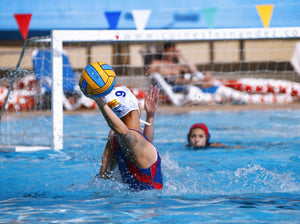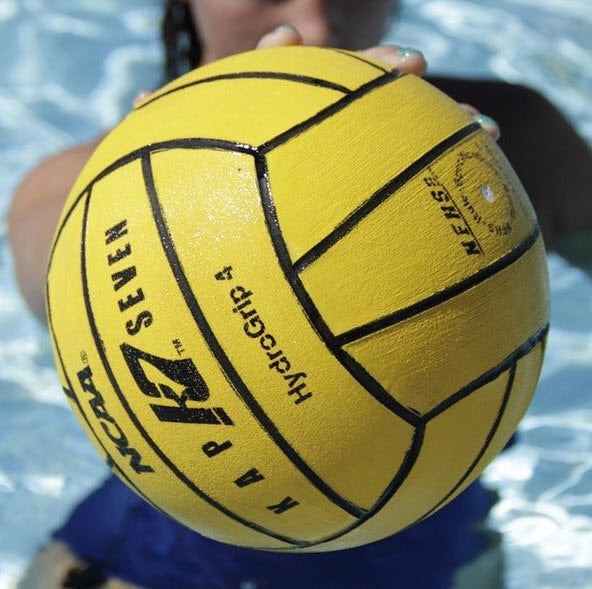How to Shoot a Timing Shot in Water Polo
 A timing shot is more of a redirected pass that happens right in front of the cage than an actual type of shot. Timing shots can be taken during a heads-up freestyle or backstroke drive. The shooter receives a pass mid-stroke and — using the momentum of the pass — pushes the ball into the goal. The pass should come from teammates on the opposite side of the perimeter so that the ball does not have to be thrown over the head of the shooter. The shot can be taken with either hand.
A timing shot is more of a redirected pass that happens right in front of the cage than an actual type of shot. Timing shots can be taken during a heads-up freestyle or backstroke drive. The shooter receives a pass mid-stroke and — using the momentum of the pass — pushes the ball into the goal. The pass should come from teammates on the opposite side of the perimeter so that the ball does not have to be thrown over the head of the shooter. The shot can be taken with either hand.
The "timing" part of the shot is in reference to the pass that is made to the shooter, since it can only happen in a small window of time. A successful timing shot requires excellent communication between the two offensive players and is less about power and more about placement and positioning. This guide explains when timing shots are appropriate, how to shoot them, and how to make a good timing shot pass.
When to Shoot a Timing Shot
A timing shot only works during specific moments in a game. When performed correctly, it is incredibly effective. Timing shots can be used in the following situations:
- When a drive doesn't work: If a drive doesn't result in a pass and shot, but the driver still has decent positioning, they may be able to eke a timing shot out of the situation.
- When the offense is not entirely set up: If the hole set hasn't yet gotten into position, the area in front of the cage is still open. A player who can get between their defender and the goal can transition to a timing shot.
- To take advantage of a bad hole defender: If the hole set can work themselves to one side the cage, they may be able to leave their defender in the dust and take a timing shot as they backstroke across the goal.
There are two main types of timing shots, both of which are explained below.
Freestyle Timing Shots
A forward-facing timing shot starts when a perimeter player decides to drive. If they plan on executing a timing shot, their drive should take them near the middle or across the front of the cage. As they swim, they should slip their arms through the water rather than taking strong strokes. This gives them more time in front of the goal and helps disguise the exact timing of their shot.
A teammate on the other side of the cage with the ball sends them a hard, straight pass. All the driver should have to do is raise their arm and redirect the ball into the cage. No catching or pump faking is necessary with a timing shot.
Drivers should use eggbeater during a timing shot to slow down their progress and also to help keep defenders off their back. The shooter should stay horizontal during the shot, so the eggbeater will also make them more stable.
Backstroke Timing Shots
The driver for a backstroke timing pass can be a flat, wing, or even the hole set. For this drive to be effective, the player driving needs to drive to the center of the cage first. As soon as their defender falls to the side or gets out of position, the offensive player needs to make a 90 degree turn and start taking short backstroke strokes across the cage. They should be eggbeatering to slow their movement and simultaneously keep their defender away.
The faster their turnover, the easier it will be for the driver to get their arms out of the water to take the shot. The driver should keep their eyes glued to the player with the ball so that they can see when the pass is launched. As with a forward-facing timing shot, the pass for a backwards timing shot must come from a wing or flat on the side opposite the driver.
Players should practice shooting timing shots with both hands. This will make them better prepared for a timing shot in a game in case the ball comes as their weak hand takes a stroke, or if their strong side is covered by a defender.
The Pass
Because the timing of the pass is so important, it often comes from a player who has drawn a foul and has a free throw, not someone who is being closely guarded. The pass should be released between the strokes of the driver so that when their arm comes up, it meets the ball as part of their stroke. The driver should never have to wait in one place with their arm raised, since this negates the valuable element of surprise.
The pass should be high and hard, with enough velocity on its own to make it to the cage. The ball needs enough power behind it so that the shooter doesn't have to pull it back and throw it again, but not so much that it is hard for them to control.
The passer and the shooter performing a timing pass need to make eye contact before the shot can happen. Knowing what to expect and when the ball is coming is vital for the shooter. Perimeter players should never make a pass for a timing shot before seeing that their teammate is expecting one.
Timing Is Everything
Timing shots are fantastic because — if performed properly — they have an excellent chance of going in the cage. The shooter is so close to the goal that they are easily able to place the ball out of the goalkeeper's reach. Practicing timing shots with and without defense is important. Start without defense to lock down the technique and the timing, and then practice with defense to mimic a game-time situation. Mastering the timing shot will open up a whole new world of scoring possibilities.



